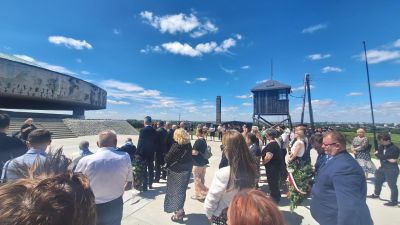
From October 1941 to July 22, 1944, approximately 130,000 prisoners of many nationalities passed through its gates, and about 78,000 lost their lives in the camp. Among them, the largest number of the dead and murdered were Jews (about 60,000 people), followed by Poles, Byelorussians, Ukrainians and Russians.
As part of the anniversary commemoration ceremony at the Mausoleum-Monument, a ceremony was held with the participation of members of the Polish Union of Former Political Prisoners of Nazi Prisons and Concentration Camps. Symbolic flowers and eloquent silence are a tribute to the victims of KL Lublin. - Here people were exterminated en masse. It was death factory. Only a few survived, usually children or those who managed to escape during the march to Kraśnik," said Jadwiga Wakulska, president of the Polish Union of Former Political Prisoners of Nazi Prisons and Concentration Camps, who was born in the German camp in Auschwitz.
The museum also invited visitors on a thematic tour of the former concentration camp site. The topic was the camp fate of Zacheusz Pawlak - author of the recently reissued memoirs entitled “I Survived.”
The concentration camp at Majdanek (KL Lublin) was planned primarily as a labor camp, a source of manpower and a place for looting property. At a certain stage of its operation, however, it became an extermination center primarily for Jewish prisoners.
The direct extermination of Jews at Majdanek took place in a bunker with gas chambers and by shooting. The building of the gas chambers was most likely erected at the behest of Odilo Globocnik, which was related to Himmler's order that the “final solution of the Jewish question” was to end on December 31, 1942.



